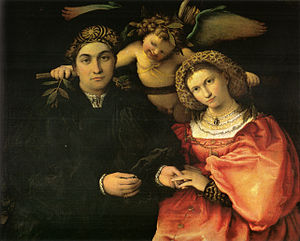Portrait of Messer Marsilio and his wife

|
| Portrait of Messer Marsilio and his wife |
|---|
| Lorenzo Lotto , 1523 |
| oil on wood |
| 84 × 71 cm |
| Museo Nacional del Prado, Madrid |
The painting Portrait of Messer Marsilio and his wife is a double portrait by the Italian painter Lorenzo Lotto from 1523 . It is now in the Museo Nacional del Prado in Madrid .
The paintings
The picture was commissioned and shows the 21-year-old Marsilio Cassotti from Bergamo , who is putting a wedding ring on his bride Faustina Assonica. According to the occasion, they wear elegant dresses, Faustina wears a precious red silk evening dress and a pearl necklace with a cameo , Marsilio is wrapped in a dark robe. Both wear scufioti , soft round caps that were common in Bergamo in the 16th century. Marsilio's cap is embossed in gold with a stylized daisy and a bold pattern of leaves, Faustina's scuffia is worked in a reticulate manner and is held in place by gold ropes with tiny decorative ribbons of blue silk. In its center is a brooch with pearls and a sapphire . Above both, in the center of the picture, is Amor , who looks at Marsilio with a smile and puts a yoke on the shoulders of the couple.
reception
With the wedding, Marsilio improved his social status, as the Assonica family held a higher social position. The painting is to be seen as an open expression of the high social status of the bride and her wealth, which should be displayed through the expensive clothing and jewelry. But the painting is more than just the wedding portrait of a wealthy couple, it is also a public and private reminder of the vows the couple made to each other, which is illustrated not least by the symbolism of the wedding ring. This symbolism is intended to reinforce the role of Faustina as a loving wife, who thereby promises to be an always loyal, faithful and devoted woman - because this is how Lorenzo Lotto painted her: reserved, standing a little behind her husband and approvingly with her head sloping. Both are connected by the mischievously smiling Cupid, who not only imposes the yoke of marriage on the couple with their pleasant rights and duties, but symbolically also the possible burdens.
background
Lorenzo Lotto made the picture for Zanin Cassotti, a prominent wool wholesaler from Bergamo. He had commissioned the work on the occasion of the wedding of his youngest son Marsilio in March 1523. In total, Zanin Cassotti had ordered five pictures from Lorenzo Lotto, which were intended for the living rooms for himself and his children. He commissioned a picture of a Madonna and Child for the room of his eldest son Zuan Maria, as well as the portrait of his son with his daughter-in-law Laura and one of their two young daughters Lucretia and Isabeta.
The price for the painting was originally set at 30 ducats , but Lorenzo Lotto reduced this to 20 ducats, possibly out of respect for a generous customer.
Lorenzo Lotto signed the painting with the words “L. LOTUS PICTOR. 1523 ”, which are on the right end (left in the picture) of the yoke held by Amor.
The word knife in the title of the picture is an earlier Italian form of address for a gentleman of a higher class.
literature
- Encyclopedia of the Museo Nacional del Prado (Spanish), accessed January 17, 2010
- Beverly Louise Brown: The bride's jewelery: Lorenzo Lotto's wedding portrait of Marsilio & Faustina Cassotti: the significance of virtue, fertility and a healthy dowry in 16th-century north Italian society can all be read in the symbolism of a wedding portrait by Lorenzo Lotto , Apollo Magazine, January 2009, ISSN 0003-6536